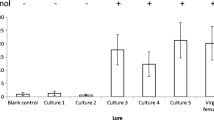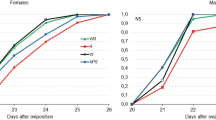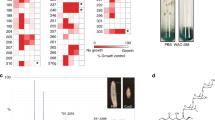Abstract
The true bugs, or heteropterans, are known for their widespread production of anti-predator chemicals and alarm pheromones in scent glands, a derived trait that constitutes one of the defining characters of the suborder Heteroptera and a potential novel trait that contributed to their diversification. We investigated whether symbiotic bacteria could be involved in the formation of these chemicals using Thasus neocalifornicus, a coreid bug that produces semiochemicals frequently found in other bugs. Using DNA phylogenetic methodology and experiments using antibiotics coupled with molecular techniques, we identified Wolbachia as the microorganism infecting the scent glands of this bug. Decreasing the level of Wobachia infection using antibiotics was correlated with a diminution of heteropteran production of defensive compounds and alarm pheromones, suggesting that this symbiotic bacterium might be implicated in the formation of chemicals.







Similar content being viewed by others
References
Aldrich JR (1988) Chemical ecology of the Heteroptera. Annu Rev Entomol 33:211–238
Ausubel FM, Brent R, Kingston RE, Moore DD, Seidman JG, Smith JA, Struhl K (1994) Curr protocols molec biol. Wiley, New York
Baumann P (2005) Biology of bacteriocyte-associated endosymbionts of plant sap-sucking insects. Annu Rev Microbiol 59:155–189
Brailovsky H, Schaefer CW, Barrera E, Packauskas RJ (1994) A revision of the genus Thasus (Hemiptera: Coreinae: Nematopodini). J NY Entomol Soc 102:318–343
Brennan LJ, Haukedal JA, Earle JC, Keddie B, Harris L (2012) Disruption of redox homeostasis leads to oxidative DNA damage in spermatocytes of Wolbachia-infected Drosophila simulans. Insect Mol Biol 21:510–520
Buchner P (1965) Endosymbiosis of animals with plant microorganisms. Interscience, New York
Choi SY, Lim JW, Kuwano K, Kim JM, Kim H (2012) Reactive oxygen species mediate Jak2/Stat3 activation and IL-8 expression in pulmonary epithelial cells stimulated with lipid-associated membrane proteins from Mycoplasma pneumoniae. Inflamm Res 39:385–389
De la Torre-Bueno RT, Ambrose WG (1936) Effects of the protective vapors of the Coreid bug Thasus gigas on a tarantula (Eurypelma sp.). Bull Brook Entomol Soc 31:184
Dobson SL, Bourtzis K, Braig HR, Jones BF, Zhou W, Rousset F, O’Neill SL (1999) Wolbachia infections are distributed throughout insect somatic and germ line tissues. Insect Biochem Mol Biol 29:153–160
Eliyahu D, Ceballos RA, Saeidi V, Becerra JX (2012) Sinergism versus potency in the defense secretions of Pentatomorpha (Heteroptera) nymphs. J Chem Ecol 38:1975–1978
Fávaro CF, de Rodrigues MACM, Aldrich JR (2011) Identification of semiochemicals in adults and nymphs of the stink bug Pallantia macunaima Grazia (Hemiptera: Pentatomidae). J Braz Chem Soc 22:58–64
Fenton A, Johnson KN, Brownlie JC, Hurst GDD (2011) Solving the Wolbachia paradox: modeling the tripartite interaction between host, Wolbachia, and a natural enemy. Am Nat 178:333–342
Hosokawa T, Koga R, Kikuchi Y, Meng XY, Fukatsu T (2010) Wolbachia as a bacteriocyte-associated nutritional mutualist. Proc Natl Acad Sci U S A 107:769–774
Huelsenbeck JP, Ronquist FR (2001) MrBayes: Bayesian inference of phylogeny. Bioinformatics 17:754–755
Hurst GD, Jiggins FM (2000) Male-killing bacteria in insects: mechanisms, incidence, and implications. Emerg Infect Dis 6:329–336
Kasai H, Maekawa M, Hachisuka K, Takahashi Y, Nakamura H, Sawa R, Matsui S, Tatsuda T (2005) 4-Oxo-2-Hexenal, a mutagen formed by ω-3 fat peroxidation, causes DNA adduct formation in mouse organs. Ind Health 43:699–701
Kikuchi Y, Fukatsu T (2003) Diversity of Wolbachia endosymbionts in heteropteran bugs. Appl Environ Microbiol 69:6082–6090
Kikuchi Y, Meng XY, Fukatsu T (2005) Gut symbiotic bacteria of the genus Burkholderia in the broad-headed bugs Riptortus clavatus and Leptocorisa chinensis (Heteroptera: Alydidae). Appl Environ Microbiol 71:4035–4043
Kikuchi Y, Hosokawa T, Fukatsu T (2007) Insect-microbe mutualism without vertical transmission: a stinkbug acquires a beneficial gut symbiont from the environment every generation. Appl Environ Microbiol 73:4308–4316
Kikuchi Y, Hosokawa T, Fukatsu T (2011) An ancient but promiscuous host-symbiont association between Burkholderia gut symbionts and their heteropteran hosts. ISME J 5:446–460
Kuechler SM, Renz P, Dettner K, Kehl S (2012) Diversity of bacterial endosymbionts of Ligaeoid bugs of the families Blissidae and Lygaeidae (Hemiptera: Heteroptera: Laygaeoidea). Appl Environ Microbiol 78:2648–2659
Lopanik NB (2014) Chemical defensive symbioses in the marine environment. Funct Ecol 28:328–340
Machtelinckx T, Van Leeuwen T, Vanholme B, Gehesquiere B, Dermauw W, Vandekerkhove B, Gheysen G, De Clercq P (2009) Wolbachia induces strong cytoplasmic incompatibility in the predatory bug Macrolophus pygmaeus. Insect Mol Biol 18:373–381
Matsuura Y, Kikuchi Y, Meng XY, Koga R, Fukatsu T (2012) Novel clade of alphaproteobacterial endosymbionts associated with stinkbugs and other arthropods. Appl Environ Microbiol 78:4149–4156
Millar JG (2005) Pheromones of true bugs. Top Curr Chem 240:37–84
Noge K, Kimura H, Abe M, Becerra JX, Tamogami S (2012a) Antibacterial activity of 4-Oxo-(E)-2-hexenal from adults and nymphs of the heteropteran, Dolycoris baccarum (Heteroptera: Pentatomidae). Biosci Biotechnol Biochem 76:1975–1978
Noge K, Prudic KL, Becerra JX (2012b) Defensive roles of heteropteran (E)-2-alkenals and related compounds. J Chem Ecol 38:1050–1056
Oliver KM, Moran NA (2009) Defensive symbionts in aphids and other insects. In: White JF, Torres MS (eds) Defensive mutualism in microbial symbiosis. CRC Press, New York
Oliver KM, Noge K, Huang EM, Campos JM, Becerra JX, Hunter MS (2012) Parasitic wasp responses to symbiont-based defense in aphids. BMC Biol 10:11
Olivier-Espejel S, Sabree ZL, Noge K, Becerra JX (2011) Gut microbiota in nymph and adults of the Giant Mesquite Bug (Thasus neocalifornicus) (Heteroptera: Coreidae) is dominated by Burkholderia acquired de novo every generation. Appl Environ Microbiol 40:1102–1110
Osborne SE, Iturbe-Ormaetxe I, Borwnlie JC, O’Neill SL, Johnson KN (2012) Antiviral protection and the importance of Wolbachia density and tissue tropism in Drosophila simulans. Appl Environ Microbiol 78:6922–6929
Pan X, Zhou G, Bian G, Lu P, Raikhel AS, Xi Z (2011) Wolbachia induces reactive oxygen species (ROS)-dependent activation of the Toll pathway to control dengue virus in the mosquito Aedes aegypti. Proc Natl Acad Sci U S A 109:E23–E31
Prudic KL, Noge K, Becerra JX (2008) Adults and nymphs de not smell the same: the different defensive compounds on the Giant Mesquite Bug (Thasus neocalifornicus: Coreidae). J Chem Ecol 34:734–741
Schaefer CW (2003) Prosorryncha. In: Resh VH, Carde RT (eds) Encyclopedia of Insects. Academic, China
Spickett CM (2013) The lipid peroxidation product 4-hydroxy-nonenal: advances in chemistry and analysis. Redox Biol 1:145–152
Staddon BW (1979) The scent glands of Heteroptera. Adv Insect Physiol 14:351–418
Wheeler WC, Schuh RT, Bang R (1993) Cladistic relationships among higher groups of Heteroptera: congruence between morphological and molecular data sets. Entomol Scand 24:121–137
White JA, Kelly SE, Cockburn SN, Perlman SJ, Hunter MS (2011) Endosymbiont consts and benefits in a parasitoid infected with both Wolbachia and Cardinium. Heredity 106:585–591
Author information
Authors and Affiliations
Corresponding author
Rights and permissions
About this article
Cite this article
Becerra, J.X., Venable, G.X. & Saeidi, V. Wolbachia-Free Heteropterans Do Not Produce Defensive Chemicals or Alarm Pheromones. J Chem Ecol 41, 593–601 (2015). https://doi.org/10.1007/s10886-015-0596-4
Received:
Revised:
Accepted:
Published:
Issue Date:
DOI: https://doi.org/10.1007/s10886-015-0596-4




